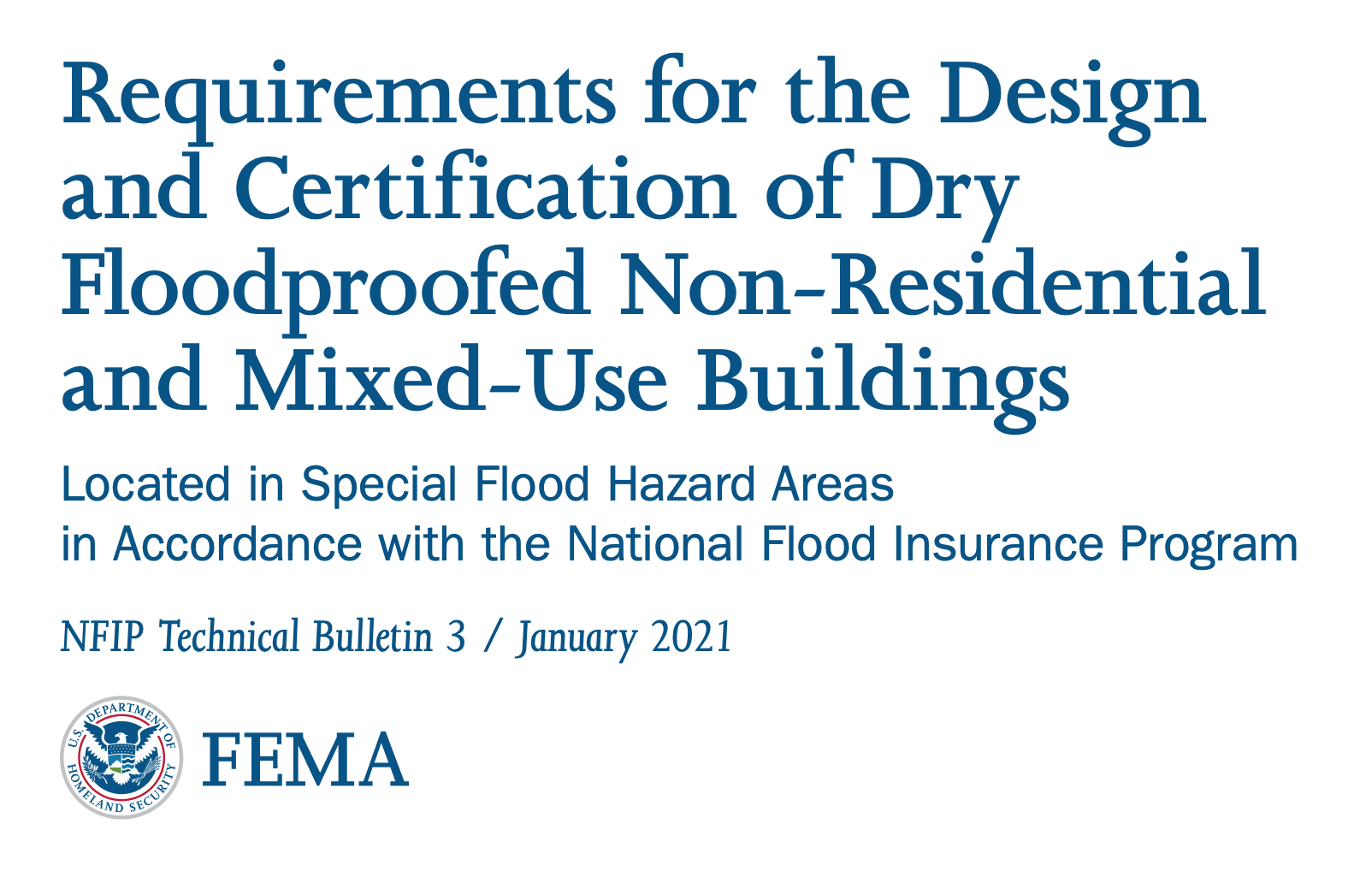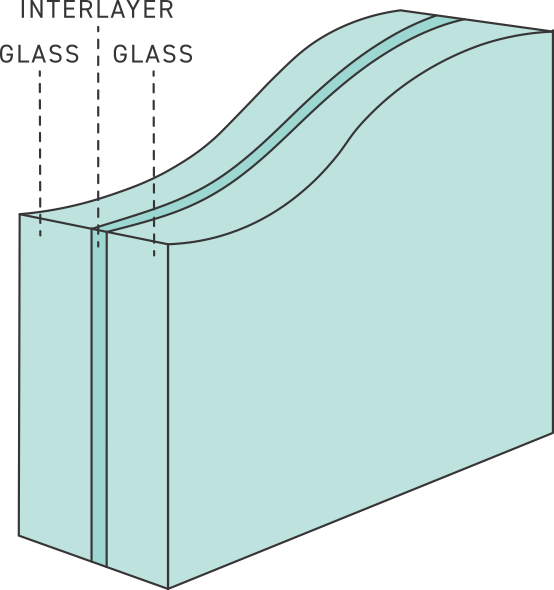Floodproof Window Systems and Glass Flood Walls
FEMA/ NFIP Technical Bulletin 3
This guidance was issued in January 2021 by the Federal Emergency Management Agency (FEMA) National Flood Insurance Program (NFIP). Flood insurance is required for many buildings, including commercial and industrial (i.e., nonresidential) facilities. This Technical Bulletin clarifies “Requirements for the Design and Certification of Dry Floodproofed Non-Residential and Mixed-Use Buildings - Located in Special Flood Hazard Areas in accordance with the National Flood Insurance Program (NFIP).”
The goal of the program and this bulletin is to make a building watertight, impermeable to floodwaters, in other words, more stringent than the ASCE-24 standard. Specifically, the walls of a building need to be designed to be waterproofed plus take a flood load up to the Design Flood Elevation (DFE). Similarly, the United States Army Corps of Engineers (USACE) definition of “Substantially Impermeable” is to be watertight to 1 foot above the Base Flood Elevation (BFE). Neither case allows the accumulation of more than 4 inches of water. In addition to impermeable walls, flood barriers are required to protect openings such as doors, windows, or vehicular entrances which are not commonly floodproof.

Credit: FEMA.gov; courtesy of Floodproofing.com
ASCE-24 and FEMA/NFIP Technical Bulletin 3 provide the basis for national standards for floodproofing design requirements.
Structural design considerations in this case include the ability to absorb impact from debris based on a 1,000-pound log traveling at 5 feet per second. The standard here is ASCE 7 - “Minimum Design Loads and Associated Criteria for Buildings and Other Structures,” which should be used as the source of how to calculate debris impact loads. In particular, ASCE 7, Section 6.11, requires designs to include the effects of debris impact forces in flood load calculations when the minimum inundation depth is 3 ft. or greater. Furthermore, all utilities and sanitary facilities must be protected in addition to the building components.
Note that dry floodproofing is acceptable under this standard in SFHA flood zones A, AE, A1-A30, AO, and AH. In all cases, the design must be certified by a design professional and/or by FEMA as suitable for protection.
There are some other considerations to be aware of that relate to regulatory requirements.
Periodic Testing
Beyond the initial design and construction, multiple standards call for periodic drills and deployment of active systems. ASCE 24, FEMA TB-3, and the NFIP Flood Insurance Manual require flood emergency and inspection plans approved by the authority having jurisdiction. Once the plan is approved, then the standards call for a periodic and annual deployment of dry floodproofing shields and barriers. The rationale is that, just like a fire drill, practice is needed to ensure the system will work. The maximum flood drill warning time is 12 hours. Then the floodproofing measures need to be installed within that warning time – i.e., under 12 hours. The results are documented, and the inspection is either considered successful or not. If need be, the drill may need to be repeated until compliance is achieved.
Local Regulations
Some localities have implemented their own requirements above and beyond the national standards which are also enforced locally. For example, ever since Hurricane Sandy, New York City requires, and is enforcing, flood drills, just like fire drills. Miami Dade County in Florida is known for its wind and severe weather requirements in buildings due to the prevalence of hurricanes there. Both of these cities, as well as others, are becoming well known for their design, construction, and periodic testing requirements for flood protection.
Ramifications of Noncompliance
There can be considerable problems if a building is found to be noncompliant related to any of these national or local regulations. First, the building could end up on the FEMA noncompliant list meaning it is regarded as a flood liability and the NFIP insurance may not cover it. Neither code enforcement officials nor design professionals want to see one of their buildings tagged this way since it transfers liability to them as a lack of enforcement or a lack of proper design.
There is also the need to be sure that if an active floodproofing solution is used, then it must be fully deployed when needed. If not, then business or operations continuity is compromised, not to mention the potential for major losses of property and lives being put at risk. Currently the NFIP pays out damage claims even if an active flood measure is not fully deployed. However, due to prior experiences this could change in the future. It is one thing if an active system is properly deployed and a larger than expected flood breaches over the top of the system – this can be seen as out of the control of building owner. But not deploying the system is like having a fire truck parked outside of a burning building and not turning on the water hose. NFIP may start to look at non-deployments in the same manner and limit damage claim payments as a result.
Now that we have reviewed some of the fundamentals of floodproofing and some of the regulatory requirements that need to be addressed, let’s turn our attention to a few design strategies that are proving to be effective and very appealing in many situations
Floodproof Window Systems
We have seen the need to create substantially impermeable conditions at and below the DFE. While opaque walls can be readily addressed for that condition, windows that extend below the DFE commonly require an active system to be deployed to protect them. An alternative is to specify and install a manufactured, passive, floodproof window system. These systems are currently available and offer the capability to be fully water impermeable while also providing the needed structural resistance to debris impact.
Floodproof window systems consist of a complete window product or fixed glass wall systems that are manufactured, fabricated, and delivered to the project site for a coordinated installation. The window units are custom sized to suit a building design, pre-glazed and sealed in a factory-controlled environment and engineered for proper anchoring to the building. delivered ready to be installed. This process eliminates any unnecessary handling of glass and frames and creates a higher quality product that is more cost-effective.
Design Attributes
Among the notable attributes of floodproof window systems, the most striking is that they are a passive system that is always ready – the floodproof windows are simply part of the glazing design of the building. Therefore, there is no need for installation before a storm nor for removal afterwards. That also means there is no need for the periodic or annual deployment as with an active system. The floodproof window systems may be subject to inspection, nonetheless, just like other permanent components of a building are, primarily to be sure that they are still properly in place, have not been damaged, or require any other maintenance
Photo courtesy of Floodproofing.com
Passive floodproof window systems can be used in a variety of building types to meet different design needs.
As a passive system, they also avoid some of the drawbacks of storing and deploying an active system. Active systems stored in basements or elsewhere may suffer from environmental corrosion, lack of maintenance, or lost pieces which inhibit their ability to be deployed easily and fully. When they are set in place, they often interfere with the pedestrian and vehicular pathways around the building such as sidewalks and drives. The passive floodproof window systems avoid all of these issues since they simply remain in place in the wall of the building.
From a performance standpoint, the available systems are independently tested following proper test standards. Some systems have demonstrated a tested compliance beyond the minimums in the regulations helping to ensure a level of safety and protection even in unexpected conditions. For example, some systems have been tested to be able to withstand up to 10 feet of standing water and still withstand the required 1,000 pounds of debris impact. Altogether, the combined attributes of these systems provide everyone involved with less concern about liability and risk management. As such, that may also translate to reduced insurance premiums for the building owner.
System Components
How do floodproof window systems achieve this combination of passive, integrated design and the needed performance? The answer is in the coordinated, engineered, nature of the different components that make up these systems.
- Glass The glass in the systems is, as might be expected, stronger than typical window glazing. Commonly, custom configured laminated glass is used that meets both building design needs and the strict testing standards for strength and impermeability. Laminated glass is commonly used in automobile windshields and buildings where security and vandal resistance are concerns. For this type of glazing, multiple layers of glass are laminated together with clear plastic or polymer interlayers. If the glass is struck by an impact, the clear interlayers help to hold it together. That is why an automobile windshield can look very cracked or damaged but is still intact or why a store window may be disfigured but won’t give way to repeated hits from a sledgehammer.
For floodproof windows, high modulus, stiff interlayers are used that can be five times stronger and up to 100 times stiffer than those used in conventional laminated glass. These interlayers allow the glass to be used in the more demanding applications of severe weather and flooding while making a thinner overall glass system possible. The stronger interlayers also create an increase in the strength of the glass after it has received an impact and may appear cracked or shattered in at least one of the glass layers. This strength is maintained over a range of temperatures as well, which can be important as floodwaters remain for days with varying weather.
The combination of glass and interlayers helps with some other conditions as well. The specific materials used are selected to retain clarity and color without being subject to yellowing over time. They can also be selected to meet thermal requirements for reflecting sunlight and reducing solar heat gain in the building. The complete glazing is less vulnerable to moisture or other conditions that can hamper traditional window systems. As such, they can be custom configured and designed to meet the glass and glazing requirements of the rest of the building too, such as fire concerns, ballistic ratings, sound deadening, and energy performance standards.

Image courtesy of Floodproofing.com
Custom laminated glass is a key material in floodproof window systems.









